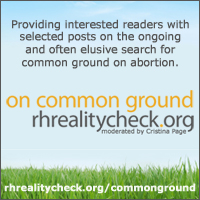Putting the Option in Adoption
One of President Obama's key common ground proposals focuses on making adoption more accessible. But what does that mean? And how do reproductive health and justice advocates work towards accomplishing the goal?
On May 17th, President Barack Obama delivered a commencement speech at Notre Dame, an independent Catholic university. In the speech, he repeated his now familiar call for common ground in the national abortion debate. Re-framing the issue, not as political one, but one that seeks, above all else, to ensure the health and well-being of women and families: "Let us work together to reduce the number of women seeking abortions, let’s reduce unintended pregnancies. Let’s make adoption more available. Let’s provide care and support for women who do carry their children to term."
It appears that these are not just hollow words and promises, but a policy stance that the Obama Administration is prepared to act upon. Obama’s newly re-envisioned White House Office of Faith-Based and Neighborhood Partnerships and the White Council on Women and Girls have been formally tasked with making adoption more accessible, among other common ground goals.
A recent Gallup poll found that the economy has prompted 1 in 10 married women to delay pregnancy. Feedback from the National Abortion Federation and from several large U.S. adoption agencies suggest that women are considering alternatives to parenting in greater numbers as a result of very real financial and employment concerns.
Still, the number of women facing unplanned pregnancies who choose adoption continues to hover around 1%, prompting a number of related questions: "Why are these numbers so low?" "What exactly does it mean to ‘make adoption more accessible?’" And how do those of us who work in and advocate for reproductive health and justice go about accomplishing this lofty, yet crucial goal?
The Adoption Access Network, a fledgling national coalition which includes family planning and abortion providers, patient-centered adoption resources, professional and academic medical associations and other stakeholders, believes that it has an answer. It begins with a focus on the woman confronting unintended pregnancy. Much of the rhetoric and policy proposals that have been put forward in recent years in the hopes of making adoption more accessible have focused on supports for those interested in adopting. While these solutions, such as adoption subsidies, and expedited adoptions from foster care are a vital piece of the puzzle, women facing unintended pregnancies and their families have been largely left out of the conversation thus far.
The Adoption Access Network proposes a three-pronged approach that addresses issues ranging from individual patient interactions to systemic change.
1. Public Education: Adoption needs to be reintroduced to the public. The perception of adoption by most Americans is stuck somewhere in the 1950s. The reality of adoption is very different indeed. Members of the public deserve to be educated about the newer, brighter reality of adoption which centers around choices for the birth mother about the adoptive family and how much contact she will have with the baby as he or she gets older. Women must feel confident that they can access further information and services from reputable, patient-centered sources if interested. A targeted national social marketing campaign in addition to local grassroots efforts can help accomplish this goal.
2. Professional Training: Family planning and other healthcare providers report that they want to be able to discuss adoption with their clients, but face a number of barriers including a lack of information and fluency in "adoption language." Others admit to subscribing to pervasive cultural myths and misconceptions about adoption or a distrust of available adoption-referral sources. The result is that women facing unintended pregnancies may not be aware of adoption as an option and may hold onto misinformation or their own biases because there is no professional to counter these beliefs.
The Adoption Access Network partners clinics and community health centers with adoption resources that meet the Network’s standards for patient-centered care to help develop "adoption fluency" among health care providers who care for women confronting unintended pregnancy. This partnership ensures that women are given access to adoption as an option with as much value as any other and that those who choose to explore adoption further have the support of a network of agencies that are steadfastly committed to ensuring her rights are protected and that she has ample time and opportunity to make the very best plan for herself and her family.
3. Referring with Confidence: The Adoption Access Network has organized a growing national network of adoption resources that fit standards for patient-centered care. Those included in the Network are proponents of reproductive choice; employ an empowerment model that encourages the birth mother’s autonomy and participation in choosing an adoptive family and creating an adoption plan with a level of openness that she is comfortable with; offer a diverse pool of prospective adoptive families for birth mothers to choose from; and provide lifelong access to post-placement counseling and other services for both the birth and adoptive families.
Adoption access is about reproductive justice in its most basic form. Women facing unplanned pregnancies have a right to accurate, unbiased information about the adoption option. As service providers, we have a responsibility to ensure that women who choose to explore adoption further have the support and guidance of agencies that will advocate for them throughout this lifelong process. They should not be forced to sacrifice comprehensive, patient-centered care simply because they choose adoption. Nor should they feel compelled to choose one option simply because the providers and systems they sought care from were not prepared to give them comprehensive information about every option available to them.

